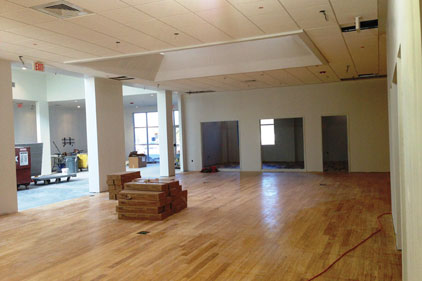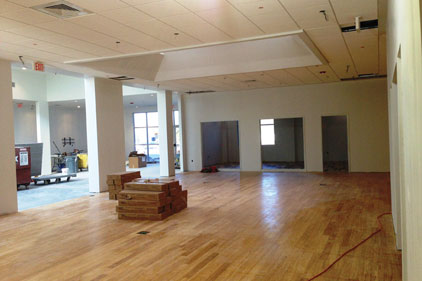
|
|
Sabra Dipping Company’s “Center of Excellence” design is open and encourages cross-functional collaboration.
Photo courtesy of The Dennis Group, LLC
|
Realizing that it needed to grab consumers’ attention, General Motors embarked on one of the automotive industry’s most bold advertising slogans, “This is not your father’s Oldsmobile,” during the late-80s to mid-90s. Although the company and car ultimately didn’t deliver, the ad slogan still reverberates with its intriguing challenge.
It’s also an apt way to describe a new generation of R&D and culinary centers. Today’s new facilities appear nothing like their drab predecessors—those sterile, white-wall and stainless-steel labs and kitchen, often hidden in corporate headquarters or factories.
If it’s true that “form follows function,” it also stands to rights that today’s new facilities literally reflect changing corporate culture. Corporate sales, marketing and R&D departments used to act independently and figuratively passed new product initiatives “over the wall” to the next group. Today, however, most (if not all) companies embrace a more multi-functional, multi-disciplinary approach to product development.
Some early adopters—including Schwan’s (2001) Heinz (2004), Tyson (2007) and Sara Lee (2009)—literally incorporated this new approach into their new innovation center designs. Likewise, they often quite literally eliminated many interior walls, so food scientists and chefs were closer to one another and could interact more quickly and freely.
After a lull in a capital spending, there’s now a new generation of processor innovation center projects. Interestingly, these facilities continue to incorporate even more features and design-build advances.
One example involves Nestlé S.A.’s new $53 million global Product Technology Center (PTC) in Solon, Ohio. Set for completion in early 2015, Nestlé’s 148,000-sq-ft facility will include test kitchens, production areas, food science labs, sensory lab and office space. Inside the facility, a smaller pilot plant will simulate food processing to test new product production and other techniques.
The PTC also will house a consumer center and a culinary center. Nestlé officials say the consumer center will allow live observations of consumer interaction with Nestlé products. In the culinary center, internal Nestlé teams will work with their food and beverage ingredient supplier-partners to see, first-hand, how the ingredients perform in recipes developed in the kitchen. Both new centers will feature presentation kitchens equipped with cameras, TVs and other technology.
One active design-build player in the field is ESI Group USA, a Hartland, Wis., firm with as many as 15 years of R&D and culinary kitchen design experience for major foodservice distributors and others. Architect Troy Gough emphasizes that research kitchens, in particular, have changed dramatically.
“Companies have upgraded their former test and R&D kitchens,” Gough says. “They wanted to make each of these facilities more of a culinary showpiece. Here, they can bring potential clients into their facility to demonstrate and display their products. We try to design these kitchens similar to a typical restaurant and/or dining establishment kitchen, so their clients literally feel more at home. With the state-of-the-art audio visual systems, chefs can host demonstrations for groups of all sizes—small to large.”
Sharing a few more details about Nestlé’s PTC building is Richard Lovelace, divisional vice president-Commercial at Stellar, the Jacksonville, Fla., design-build firm involved with the project. He notes that, unlike a traditional office building with fixed walls and dropped ceilings, the PTC design is based on openness and flexibility.
“Nestlé’s goal was to create a facility that promotes collaboration and creativity,” he says. “Large glass curtain walls with metal panels surround the exterior, while the interior features exposed structural elements and mechanical, electrical and plumbing systems.”
Lovelace says the new building also will include many sustainability features and is being designed to LEED standards.
“The facility will feature LED lighting, low-VOC products and recyclable materials,” he notes. “A particular environmental highlight is the use of all-natural refrigerants in both the mechanical and refrigeration systems.”
Pilot Plant: Operations Meets Innovation
High-tech kitchens. Green building designs. How about a pilot plant? In her Prepared Foods interview, Sabra chief technology officer Tulin Tuzel says pilot plant operations have become a “must-have” feature (see “Innovation Insights,” p. 30) for any new R&D center. And, that was one of the many Sabra project components executed by the company’s design-build partner, The Dennis Group, LLC, Springfield, Mass.
Dan McCreary is a Dennis Group principal and Sabra project manager. He notes that his firm has nearly three decades of food and beverage facility expertise, including projects where companies are scaling up operations from a pilot plant environment.
“In a way, these types of projects [involving a new pilot plant in an innovation center] can be thought of as reverse engineering,” says McCreary.
With that, McCreary also shares advice for any processor considering a new innovation center with a pilot plant.
Small Scale but Same Needs: Pilot plant operations often require all of the elements of an operating plant, such as receiving and shipping areas, process utility systems, CIP systems, waste treatment systems, maintenance shops, coolers, freezers and more. However, everything is on a smaller scale, which can challenge design efficiency.
Flexibility, Built-in: Understandably, product development and pilot plants need operational flexibility—certainly more than full-scale production lines. However, that flexibility has to be balanced against a certain practicality. For instance, a very flexible operation is likely to not be particularly efficient, but it can’t be so inefficient that the results are questioned. No one wants R&D saying, “I can’t really run this in the pilot plant, but I’m sure it will scale up just fine.”
Part Plant/Part Lab: Pilot plants need responsive environmental systems. Full-scale manufacturing operations often are staffed 24/7 and are kept lighted and conditioned around the clock. However, a smaller developmental operation typically is staffed only during office hours, and may not operate for days at a time. It’s important that a pilot plant be able to act like both a manufacturing plant and a lab—nearly simultaneously.
Prepared Foods asked McCreary to compare Sabra’s Center of Excellence to older, more traditional R&D center designs.
“Sabra’s Center of Excellence was conceived as a stand-alone entity, one with a very different purpose, objectives and ‘feel’ than the day-to-day operations,” he says. “Ten years ago, such an operation might have been carved out of space within a manufacturing plant, and it might have felt more like an afterthought—particularly with a pilot plant located far away from lab space.”
“Sabra is different,” he continues. “The adjacencies make sense from a developmental perspective. Sabra can conceive products in the Ideation Center; develop at a very small scale in its Consumer Kitchen; hold focus groups in a home kitchen setting; move onto its Commercial Kitchen, then to the pilot plant. Finally, it can commercialize a product in its state-of-the-art processing facility. Everything’s not only on the same campus, but it’s arranged in way that promotes cross-functional cooperation. Developmental projects are no longer organized in silos and passed from team-to-team-to-team. Sabra’s Center of Excellence is built around and promotes an innovative, collaborative and responsive developmental team.”

